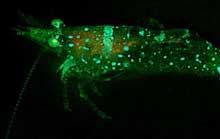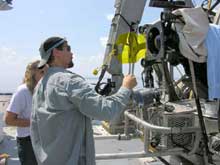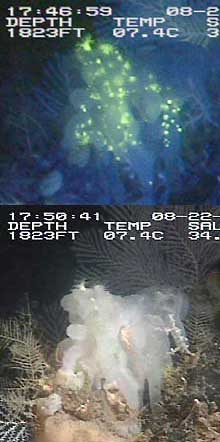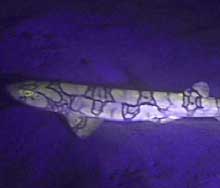
Unidentified sargassum shrimp bearing two colors of fluorescent patches. Click image for larger view and credits.
The Day We Found the Jaguar Shark
August 22, 2005
Mikhail Matz, Ph.D.
Research Assistant Professor
University of Florida
![]() Zooanthids With Intensely Fluorescent Polyps
Zooanthids With Intensely Fluorescent Polyps
![]() A Fluorescent Tube Anemone Found At The Vioska Knoll Site
A Fluorescent Tube Anemone Found At The Vioska Knoll Site
Latitude: 26° 20.006' N
Longitude: 84° 45.985' W
We woke up to a morning that appeared almost unnaturally beautiful. The ocean was calmer than I have ever seen it - one could see a school of fish swimming 30 (well, at least 20) feet below the surface. On such a day, I reasoned, we are most likely of all days to film the Giant Squid, catch the Scarlet-Eyed Lobster and/or find the terrifying but magnificent Jaguar Shark. Surely enough, the Giant Squid still likes to be sighted in South Pacific rather than in the Gulf of Mexico, the Jaguar Shark is found only in “The Life Aquatic” movie and as for the Scarlet-Eyed Lobster, I just made this one up. Still, physicists tell us that things that are believed to be impossible are in fact only ALMOST impossible. In other words, they are a tiny bit possible after all. Today was a day when this kind of thought felt particularly encouraging.

Dr. Mikhail Matz checking his yellow submersible light filters prior to launch. Click image for larger view.
But we don’t really BELIEVE in the Jaguar Shark, do we? The huge deep-sea monster that is all covered with brightly glowing yellow spots? Well, in fact, it does not seem so outrageously improbable. We’ve seen quite a few unexpected glowing things, including a fluorescent fish, during the first Deep Scope exploration in 2004. This very morning Karen Konzen, a technician in my lab, and I spent several hours photographing and preserving small brightly fluorescent shrimp found only yesterday, inhabiting the sargassum seaweed in great numbers. But most notably, last year on one of the Deep Scope 2004 dives, Charlie Mazel (the designer of the fluorescence detection filters for the submersible) actually encountered a glowing shark, only could not catch it properly on video. This afternoon would be the first dive of this cruise with Dr. Mazel’s add-on filters on the sub, and it will be Karen and I who are diving. What if we are lucky?
Not too long after an exquisitely delicious lunch of mahi-mahi and wahoo caught by some of the ship’s crew yesterday (did I mention it felt like a beautiful day from the very morning?), we began to get ready for the dive. In my case “getting ready” chiefly meant refusing myself three of the five cups of tea I would normally drink between 12 and 4 pm. Better a bit of discomfort on the surface than a lot of it down at 1800 feet during a three-hour dive. Karen was to dive for the first time, and as far as I could tell, was simply busy being excited. Other people on the ship also prepared for our dive – in fact, we were to perform almost the whole range of signature Deep Scope tasks: deploy Dr. Widder’s Eye-in-the-Sea, collect Dr. Frank’s benthic traps, put out new traps and then survey the area for fluorescent features and creatures.
Here we go at last! Our sub is lowered into the glassy water (in such a weather the ship’s stern looks like the edge of a swimming pool) and we start our descent. The light goes blue, then turquoise, then gray and finally it becomes dark. Our pilot Hugo Marrero fires up the huge arc light on top of the sub. A small but vicious-looking viper fish (longest teeth relative to body size among vertebrate animals) bumps into the sphere – welcome to the deep, 1800 feet, bottom in sight.

Zooanthid polyps under fluorescent light setting and under white light. Click image for larger view.
It took us some time to find the
pinging beacon identifying the location of Dr. Frank’s baited traps
among rock outcrops, but here we are. The benthic traps present a really
amusing sight: there are seven red deepsea crabs holding on to them that
are simply too huge to squeeze through, although they keep trying. Two
small squat lobsters observing the scene from some distance would fit into
the traps handsomely, but they just cannot get there because of the feisty
crabs. A huge hagfish, at least 2.5 feet long, swims towards the traps
and heads straight for the entrance – SNAP! The poor
blind hagfish jerks, wriggles and keeps trying to get to the smelly bait
inside, but the defending crab would not budge. ![]() Watch the
crabs and the hagfish in action.
We collect the traps and put out new ones – half
of the crabs immediately move to the new traps and resume their hopeless
attempts to squeeze in, while other crabs march off smartly (followed by
the hagfish) in the direction of the bait box of the just-deployed Eye-in-the-Sea.
Watch the
crabs and the hagfish in action.
We collect the traps and put out new ones – half
of the crabs immediately move to the new traps and resume their hopeless
attempts to squeeze in, while other crabs march off smartly (followed by
the hagfish) in the direction of the bait box of the just-deployed Eye-in-the-Sea.
At last! We fire up the blue lights, turn off the white lights, close
the yellow filter on the camera and put on yellow goggles. In this way
all we will see is the fluorescent glow – the transformation of blue
light into other colors. Right in front of the sub on top of the rock is
something shining bright yellow, like a little Christmas tree. I zoom in
on the camera – it is a colony of zooanthids (remote relatives of
corals) with intensely fluorescent polyps extending their tentacles in
search of prey.
![]() Zooanthids With Intensely Fluorescent Polyps. Wonderful! One
more piece of evidence for the possible role of fluorescence in predator-prey
interaction in the deep, collected into jar number 1, then…
Zooanthids With Intensely Fluorescent Polyps. Wonderful! One
more piece of evidence for the possible role of fluorescence in predator-prey
interaction in the deep, collected into jar number 1, then…

Fluorescent chain cat shark at about 1820’ feet deep. This shark was no more than a meter long and “posed” for a couple of minutes lying still on the bottom near the submersible. Click image for larger view.
I wanted to check out the mud flat between the rock outcrops, hoping to
stumble upon a ![]() tube anemone or the fluorescent fish called shortnose greeneye
(both finds of Deep Scope 2004 expedition). Hugo turns the sub around and…..there
it is, gracefully swimming a few inches off the bottom in the blue light,
all in bright glowing yellow spots – my Jaguar Shark! Camera! Zoom!
Focus! Noooo! This is the WRONG joystick! Focus!!! YOU’LL LOSE IT! But
the shark stops swimming and just sits there on the bottom, posing in our
blue beam. Wow… It is not more than a meter long, with a fine black
chain-like pattern on the bright glowing yellow background – in fact,
much more elegant and beautiful than the monster in the “Life Aquatic” movie.
tube anemone or the fluorescent fish called shortnose greeneye
(both finds of Deep Scope 2004 expedition). Hugo turns the sub around and…..there
it is, gracefully swimming a few inches off the bottom in the blue light,
all in bright glowing yellow spots – my Jaguar Shark! Camera! Zoom!
Focus! Noooo! This is the WRONG joystick! Focus!!! YOU’LL LOSE IT! But
the shark stops swimming and just sits there on the bottom, posing in our
blue beam. Wow… It is not more than a meter long, with a fine black
chain-like pattern on the bright glowing yellow background – in fact,
much more elegant and beautiful than the monster in the “Life Aquatic” movie. ![]() Watch
the Fluorescent Chain Cat Shark in motion.
Watch
the Fluorescent Chain Cat Shark in motion.

The exuberant science crew watching video footage of the chain cat shark. Click image for larger view.
A fairy tale springing to life, a dream come true – how does it feel? One friend of mine said it must be a bit like Enlightenment – one suddenly becomes intensely aware of the whole mysterious Universe existing in this very nick of space and time. Yep! That’s how it feels.
The shark is not a new species, I must say. It was described before as “chain cat shark.” Since it already has a “cat” in the name, why not change it to “jaguar”? Chain jaguar shark? Sounds good to me!


























